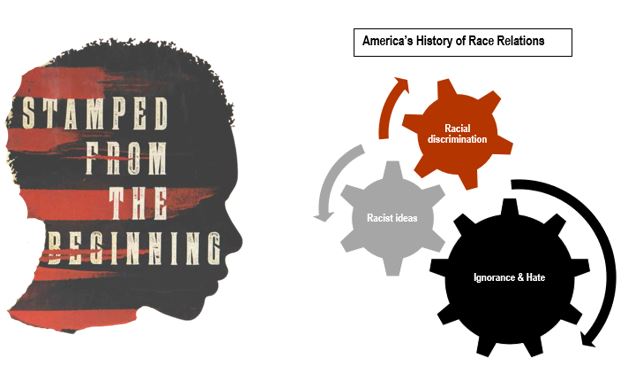Introduction
Stamped from the Beginning chronicles the development of racist ideas, and the ongoing failure of American society to root out these ideas. Throughout time, racist ideas about Black people have perpetuated racial discrimination against Black people, and have led the consumers of racist ideas to believe there is something inherently wrong with Black people.
Ibram X. Kendi focuses his efforts on emphasizing that the policies and the history of oppression and racial discrimination of Black people have made opportunities for Black people scarce. And it is truly this scarcity of Black opportunities that is inferior – not Black people.
It’s clear that racism and discrimination are still highly pervasive in today’s world. And while there are multiple angles to the current problem of race, I want to spend this post unpacking the long-term economic implications of the consistent scarcity of opportunities faced by Black people. The end of slavery for many Black Americans was just the beginning of a larger quest for economic and democratic equality.
But First … What’s A Good Definition of Racism and Racist Ideas?
Any concept that regards one racial group as inferior or superior to another racial group in any way is a good definition for racism as illustrated in this book. And historically, there have been two kinds of racist camps in the World:
(1) The Segregationists
(2) The Assimilationists
The best way to separate the Segregationists from the Assimilationists is to think of their racist ideas as a spectrum. The Segregationists regard Black people as biologically distinct and inferior to White people while the Assimilationists encourage Black people to adopt White cultural traits and/or physical ideas.
Assimilationists read Darwin as saying Black people could one day evolve into White civilization; Segregationists read Darwin as saying Black people were bound for extinction. Both camps are racist because they each regard White people (on racial group) as superior to Black people (other racial group).
In stark contrast to the Segregationists and Assimilationists stand the Anti-Racists; people who think there is nothing wrong with Black people and think that Black people as a whole are an equal racial group to all. Anti-Racists are truly committed to racial equality and focused on interrogating and shedding our world’s racist ideas.
In American history specifically, there have been four major fathers of Segregationist and Assimilationist ideas and one major mother of Anti-Racist ideas. While far from exhaustive, the graphic below depicts each individual:
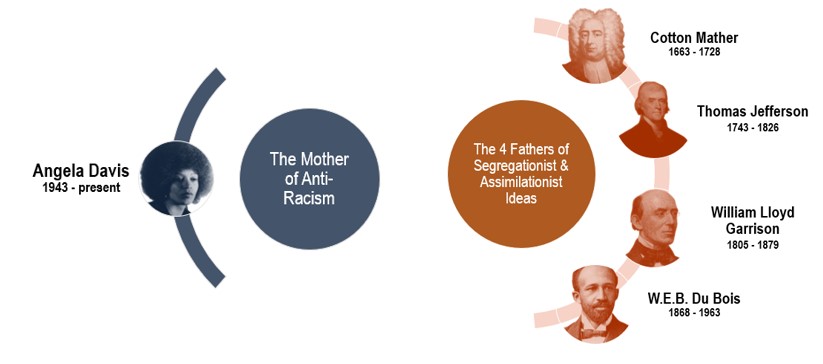
Why Do These Delineations Matter?
The delineations between Segregationist, Assimilationist, and Anti-Racists matter simply because the issue of the 21st century is “the problem of the color line” that is a result of the racist ideas that have been perpetuated by Segregationist and Assimilationists alike. As multiple series of separate but unequal laws were instituted, nearly ever aspect of southern life from water fountains, to businesses, to transportation were segregated. These separate and inferior Black facilities and opportunities fed White people and Black people alike the segregationist idea of Black people being fundamentally separate and inferior people. It is these racist ideas that have led to policies that have on average rendered Black Americans second-class status socially, economically, and politically.
So, although official segregation is dead, we as an American society still face a real “problem of the color line.” The laws against color can be removed, but that will leave the poverty that is historical and institutionalized consequence of color. For some three centuries now, the communal experiences of the slaves and their descendants has been adversely shaped by social, economic, and political institutions of our ignoble past[1]. And the true American tragedy is our current reluctance to engage in conversations to fix the results of this ignoble past. As nearly two average American lifetimes (79 years) have passed since the end of slavery, America’s national sin is now the responsibility of the third and fourth generations to fix[2].
Slavery Fueled the Growth of the American Economy; Cotton Fueled America’s Growth as a Global Player
The first slaves arrived from West Africa in 1619 and by 1776 slavery was everywhere and legal in all 13 newly created states. But it wasn’t until the rise of cotton during the 19th century that the US went from a colonial and primarily agricultural economy to the second largest industrial power in the world. Cotton created an interconnected global market that linked the industrial textile mills of the Northern states and England with the cotton plantations of the American South. And slave labor fueled it all.
As the following chart shows, cotton-based slavery became America’s first big business:
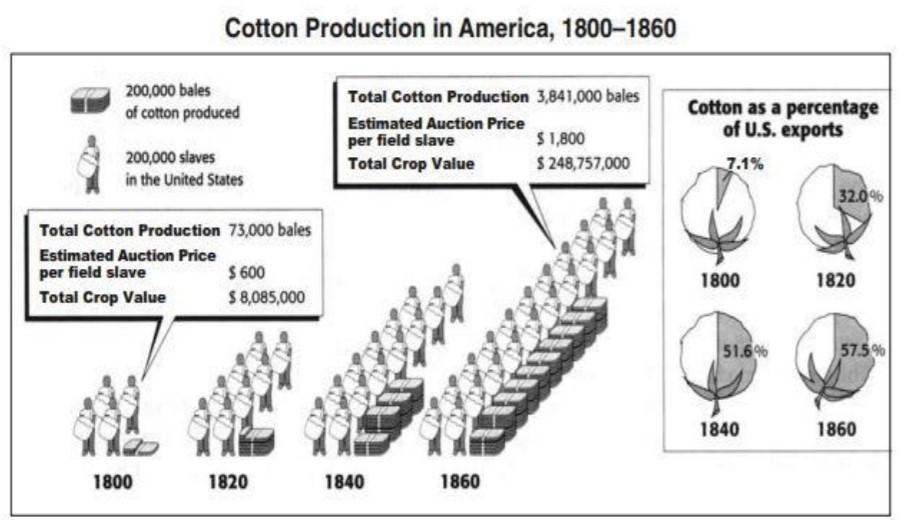
As cotton production grew exponentially (roughly 400% over 60 years), so did the number of the enslaved (roughly to 4 million people by 1860). The bodies of the enslaved served as America’s largest financial asset and became the force needed to maintain America’s most exported commodity[3]. More than just cotton, this new US economy accelerated worldwide commercial markets in the 19th century, creating demand for innovative contracts, novel financial products, and modern forms of insurance and credit[4].
Cotton profits propelled the United States into a position as one of the leading economies in the world, and made the South its most prosperous region. Unquestionably, cotton-based slavery transformed the American economy.
The Myth of the Antiracist North and the Racist South
When current day citizens look back at the atrocities of slavery, they often pin these atrocities on the South, and the South alone. Doing so, downplays the true capitalistic nature of cotton-based slavery. Because cotton was the number one export from the US during the 19th century, there was a very tight relationship between slavery in the South and the economic and industrial expansions that happened in the North and other parts of the Western worlds. Put very simply, the slavery economy of the US South was deeply tied financially to the North, to Britain, and the rest of the modern Western Worlds.
The benefits of cotton produced by enslaved workers extended to industries beyond the South. In the North and Great Britain, cotton mills hummed, while financial and shipping industries also saw gains. Banks in New York and London provided capital to new and expanding plantations for purchasing both land and enslaved workers[5]. Everyone in power benefited from the system of slavery except of course the millions of enslaved.
Today’s racial wealth gap is perhaps the most glaring legacy of American slavery and the violent economic discrimination and dispossessions that followed[6]. And failure to provide the formerly enslaved with the land grants of 40 acres originally promised through Sherman’s order only accelerated this wealth gap.
Today’s Racial Wealth Gap Began in the Past
Since the Civil War, Black people have faced social, economic, and political headwinds that provided limited opportunities for Black people to accumulate wealth. Even post-Reconstruction, Black people faced law and public policy that was disadvantageous to their cause. Through the first half of the 20th century, the federal government actively excluded Black people from government wealth-building programs like the New Deal.
Between 1944 and 1971, federal spending for former soldiers totaled over $95 billion. Combined with the New Deal and suburban housing construction, the GI Bill gave birth to the White middle class and winded the economic gap between the races. But as our nation tends to do with programs like these, Black veterans faced discrimination that reduced or denied their benefits under the New Deal welfare programs.
The continuous scarcity of Black wealth building opportunities is one of the biggest reasons why the wealth gap started in the past and continues on today. In many ways, the opportunity to accumulate wealth is contingent on the wealth positions of one’s parents and grandparents. As the stats below will show, the descendants of slaves suffer from a scarcity of opportunities that will have lasting adverse impacts on Black wealth as a whole.
The following are some stats on the disparities in wealth between Black and White households.
- White Americans have 7x the wealth of Black Americans on average
- Median family wealth for white people is $171,000. Median family wealth for black people is $17,600
- White households earned a median income of $69,823 in 2019 versus $43,862 for Black households
- Black people make up nearly 13% of the US population by hold less than 3% of the nation’s total wealth
- Black households have on average $4,400 in home equity, compared with $67,800 for white households.
- The gap in homeownership rates in 2019 between Black and white households—about 41% for Black Americans versus 73% for whites—was the widest in a quarter-century, according to census data.
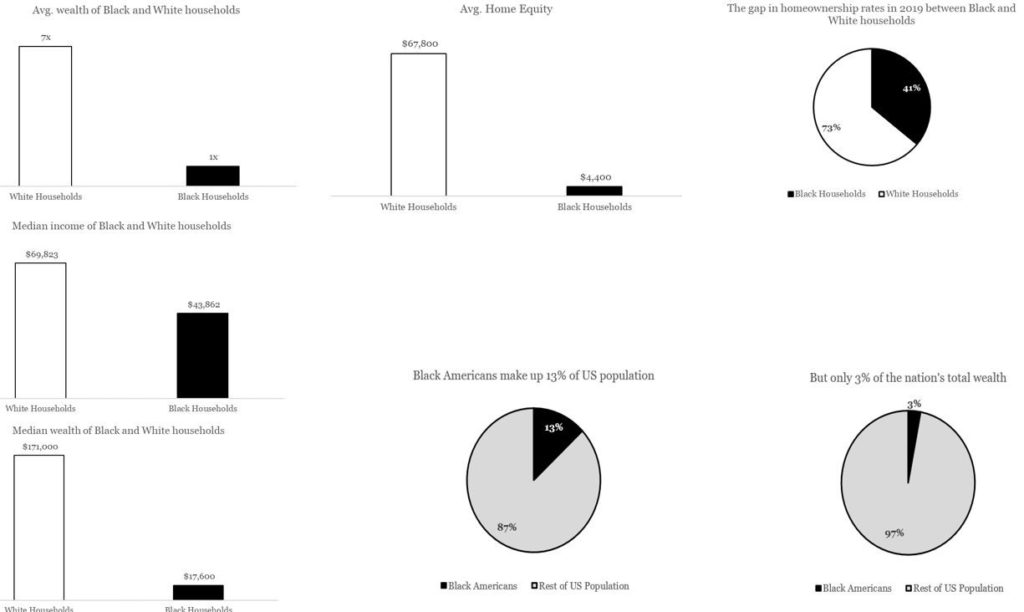
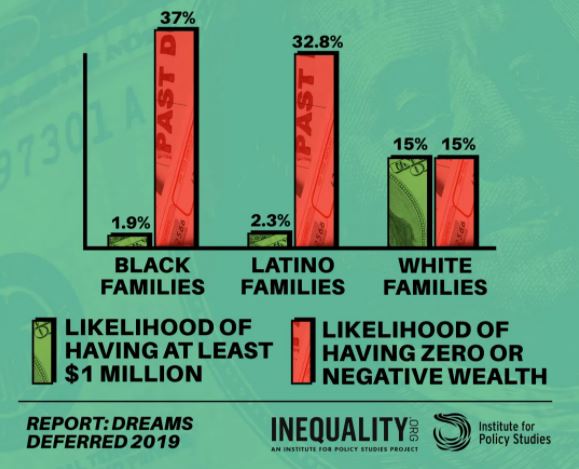
Mutual Obligation to Fix the Devastating Legacy of Slavery and Discrimination
There is no silver bullet to correct the inequalities that are 400 years in the making and deeply ingrained in our systems, institutions, and laws, Richard Neal (D., Mass.), chairman of the House Ways and Means Committee, wrote in a recent report on health and economic equity[7]. While we cannot change the past, we as Americans must not also be indifferent to the current suffering that is linked directly to that same past.
Our history has in fact dealt Black Americans a bad hand; one of inherited poverty and a devastating legacy of discrimination. Collectively, we as a people must work together to address this nation’s unfinished racial opportunity.
Not tackling the question of past discrimination is akin to asking Black people to enter the 100-yeard dash forty yards behind the starting line. And when Black people lose the dashes and the racial disparities of our country persist, racists blamed the supposed slowness of Black people, not the head start of accumulated White privilege.
What the survivors of slavery endured in the cotton fields has everything to do with the wealth of the US today and the disproportions of the wealth between While people in the US on average and the wealth of Black people in the US on average. Continuing to turn a blind eye to this fact is our nation’s continual sin.
The Extras…
My Book Review on Goodreads
Ibram X. Kendi TED Talk
Ten policy solutions to the current Racial Wealth Gap
A taxation solution to the current Racial Wealth Gap
Sources
[1] Loury, Glenn C. (1998, March 1). An American Tragedy: The legacy of slavery lingers in our cities’ ghettos. Retrieved from https://www.brookings.edu/articles/an-american-tragedy-the-legacy-of-slavery-lingers-in-our-cities-ghettos/
[2] Desmond, Matthew. (2019, August 14). In order to understand the brutality of American capitalism, you have to start on the plantation. Retrieved from https://www.nytimes.com/interactive/2019/08/14/magazine/slavery-capitalism.html
[3] Lockhart, P.R. (2019, August 16). How slavery became America’s first big business. Retrieved from https://www.vox.com/identities/2019/8/16/20806069/slavery-economy-capitalism-violence-cotton-edward-baptist
[4] Baradaran, Mehrsa. (2019, August 14). Cotton and the Global Market. Retrieved from https://www.nytimes.com/interactive/2019/08/14/magazine/slavery-capitalism.html
[5] Timmons, Greg (2018, March 6). How slavery Became the Economic Engine of the South. Retrieved from https://www.history.com/news/slavery-profitable-southern-economy
[6] Lee, Trymaine (2019, August 14) A vast wealth gap, driven by segregation, redlining, evictions, and exclusion, separates black and white America. Retrieved from https://www.nytimes.com/interactive/2019/08/14/magazine/racial-wealth-gap.html
[7] Tergesen, Anne and Gillers, Heather. (2021, February 22). U.S. Retirement Crisis Hits Black Americans Hard. Retrieved from https://www.wsj.com/articles/u-s-retirement-crisis-hits-black-americans-hard-11613989981?mod=djem10point
[8] Kendi, Ibram X. (2016). Stamped from the Beginning: The Definitive History of Racist Ideas in America. Bold Type Books.

